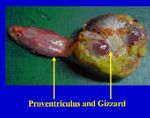Difference between revisions of "Gizzard - Anatomy & Physiology"
Jump to navigation
Jump to search
| Line 4: | Line 4: | ||
The gizzard is also referred to as the muscular stomach. It is connected by the isthmus to the [[The Proventriculus - Anatomy & Physiology|proventriculus]] and to the duodenum. | The gizzard is also referred to as the muscular stomach. It is connected by the isthmus to the [[The Proventriculus - Anatomy & Physiology|proventriculus]] and to the duodenum. | ||
| + | |||
==Structure and Function== | ==Structure and Function== | ||
| Line 10: | Line 11: | ||
*Mechanical reduction of tougher material through powerful muscular development | *Mechanical reduction of tougher material through powerful muscular development | ||
| − | * | + | *Cranial to the liver and spleen (contacts the liver) |
*Contacts the sternum and lower left abdominal wall | *Contacts the sternum and lower left abdominal wall | ||
| + | |||
| + | *Dorsally the abdominal air sacs separate it from the intestines and gonads | ||
| + | |||
| + | *Duodenum and pancreas lies in its caudal right surface | ||
*More caudal than the [[The Proventriculus - Anatomy & Physiology|proventriculus]] | *More caudal than the [[The Proventriculus - Anatomy & Physiology|proventriculus]] | ||
| Line 29: | Line 34: | ||
*In seed eating birds grit is digested to increase grinding down of food particles | *In seed eating birds grit is digested to increase grinding down of food particles | ||
| + | |||
| + | *Surface covered by glistening tendonous layer | ||
| + | |||
| + | *The cranial and caudal extremities are formed by powerful red muscular tissue | ||
| + | |||
| + | *A circular aponeurosis is present connecting the cranial end of the gizzard to the isthmus and the caudal end to the duodenum | ||
| Line 34: | Line 45: | ||
*Thin, but tough mucous membrane | *Thin, but tough mucous membrane | ||
| + | |||
| + | *Pale, thin lining raised into ridges | ||
| + | |||
| + | *3 layers of lamina muscularis | ||
*Cuboidal epithelium | *Cuboidal epithelium | ||
| Line 49: | Line 64: | ||
*No gizzard in stringiformes (owls etc.) | *No gizzard in stringiformes (owls etc.) | ||
| + | |||
| + | *No gizzard in gulls | ||
Revision as of 16:34, 7 July 2008
Introduction
The gizzard is also referred to as the muscular stomach. It is connected by the isthmus to the proventriculus and to the duodenum.
Structure and Function
- Mechanical reduction of tougher material through powerful muscular development
- Cranial to the liver and spleen (contacts the liver)
- Contacts the sternum and lower left abdominal wall
- Dorsally the abdominal air sacs separate it from the intestines and gonads
- Duodenum and pancreas lies in its caudal right surface
- More caudal than the proventriculus
- Roughly on the midline of the bird
- Lens shaped
- Interior elongated by cranial and caudal blind sacs
- Cranial blind sac contacts proventriculus
- Pylorus on right surface next to cranial blind sac
- Two thick masses of muscle that insert on tendonous surfaces
- In seed eating birds grit is digested to increase grinding down of food particles
- Surface covered by glistening tendonous layer
- The cranial and caudal extremities are formed by powerful red muscular tissue
- A circular aponeurosis is present connecting the cranial end of the gizzard to the isthmus and the caudal end to the duodenum
Histology
- Thin, but tough mucous membrane
- Pale, thin lining raised into ridges
- 3 layers of lamina muscularis
- Cuboidal epithelium
- Tubular glands
- Cuticle of koilin a carbohydrate complex is present due to the solidifying of the glandular secretion. It is replenished as it is worn down.
- Thick keratin layer to protect muscle
Species Diffences
- No gizzard in falconiformes (raptors etc.)
- No gizzard in stringiformes (owls etc.)
- No gizzard in gulls
Other Information
- Grit should be provided in seed eating birds diet. It is radiodense and marks out where the gizzard is located on radiographs.
